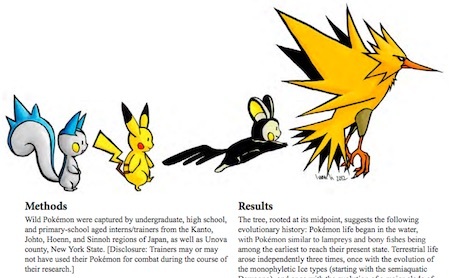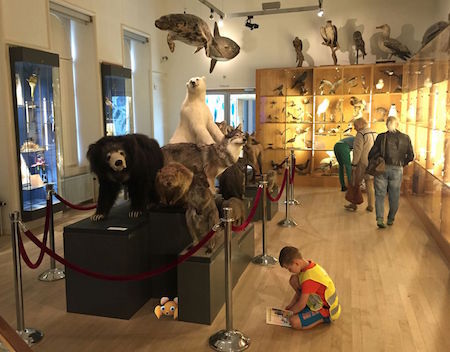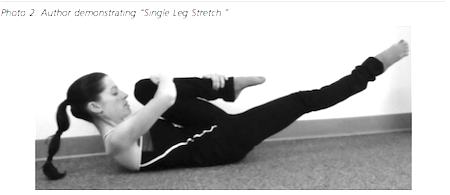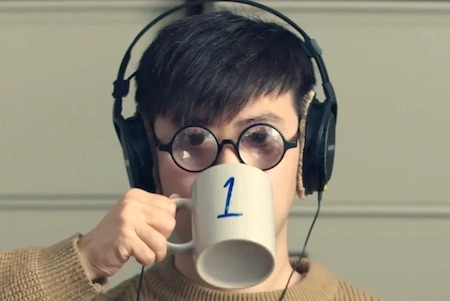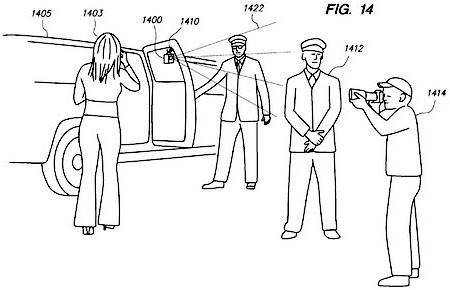Marc Abrahams's Blog, page 260
July 16, 2016
A Phylogeny and Evolutionary History of the Pokémon
Pokémon scholarship reached its height with the study “A Phylogeny and Evolutionary History of the Pokémon“, by Matan Shelomi, Andrew Richards, Ivana Li, and Yukinari Okido, which was published in the Annals of Improbable Research, vol. 18, no 4, June/July 2012. Here’s a bit of detail from that study (click on the image to see the entire study):
Aggie TV interviewed three of the researchers:
Their institution, The University of California, Davis, wrote about the study and its impact.
Pokémon is the latest once-obscure academic topic to become wildly popular (thanks in this case to the Pokémon Go app) with the public.
Thanks to the Pokémon Go app, Pokémon characters now inhabit many academic institutions. Here is an action photo taken this week at the Natural History Museum in Rotterdam (the institution famed for its role in Dead Duck Day):

Katy Croff Bell joins Luxuriant Flowing Hair Club for Scientists (LFHCfS)
Katy Croff Bell has joined the Luxuriant Flowing Hair Club for Scientists (LFHCfS). She says:
I believe that there is a linear relationship between my hair length and scientific prowess. I have had luxuriant flowing hair since 1991, when I won 2nd place at the Greater San Diego Science and Engineering Fair, thus launching my scientific career. I am now an oceanographer and find that the best place for my hair to enjoy its natural state is at sea, in particular in the seat of the crane where it can flow luxuriantly.
Kay Croff Bell, Ph.D, LFHCfS
VP, Exploration & Research
Ocean Exploration Trust
Old Lyme, Connecticut, USA


July 15, 2016
Sharp shaped vegetation lifts property prices (new study)
Residential property owners who want increase the sale price of their property can try a new way of adding value – plant some palm trees out front. See: ‘Money in your palm: Sharp shaped vegetation in the surroundings increase the subjective value of houses.’ Journal of Environmental Psychology, Volume 46, June 2016, Pages 176–187
“We demonstrated that houses surrounded by sharp leaf vegetation (SLV) were evaluated as more expensive than houses surrounded by round leaf vegetation (RLV)”
 Thus, the house shown above right was rated (by non-expert experimental raters recruited through Amazon MTurk) as being worth less than the same house when shown surrounded by palm-like vegetation. But, you may ask, “Why?” In which case, the authors have an explanation for you :
Thus, the house shown above right was rated (by non-expert experimental raters recruited through Amazon MTurk) as being worth less than the same house when shown surrounded by palm-like vegetation. But, you may ask, “Why?” In which case, the authors have an explanation for you :
“The perceived higher values and safety of houses surrounded by palms is attributed to the association of palms with suitable and stable living environments. Furthermore, preference for palm habitats may have deep roots of human evolution in African savannas.”
Coming Soon : The ups and downs of waterside properties

July 14, 2016
Evaporation of a Drop of Ouzo
If you dribble a drop of ouzo (which ouzo vendors assure us is Greece’s most popular drink) a dribbling that can easily happen if you have drunk many drops of ouzo, what happens to that drop? A newly published study peers tightly at that question:
“Evaporation-triggered microdroplet nucleation and the four life phases of an evaporating Ouzo drop,” Huanshu Tan, Christian Diddens, Pengyu Lyu, Hans Kuerten, Xuehua Zhang, and Detlef Lohse, Proceedings of the National Academy of Sciences of the United States of America, July 15, 2016. (And there’s a shorter, downloadable version.) The ouzo researchers are at University of Twente, The Netherlands, Eindhoven University of Technology, The Netherlands; Royal Melbourne Institute of Technology University, Australia; and eMax Planck Institute for Dynamics and Self-Organization, Germany. Here’s a bit of detail from the study:
“[There are] four life phases: In phase I, the spherical cap-shaped droplet remains transparent while the more volatile ethanol is evaporating, preferentially at the rim of the drop because of the singularity there. This leads to a local ethanol concentration reduction and correspondingly to oil droplet nucleation there. This is the beginning of phase II, in which oil microdroplets quickly nucleate in the whole drop, leading to its milky color that typifies the so-called “Ouzo effect.” Once all ethanol has evaporated, the drop, which now has a characteristic nonspherical cap shape, has become clear again, with a water drop sitting on an oil ring (phase III), finalizing the phase inversion. Finally, in phase IV, all water has evaporated, leaving behind a tiny spherical cap-shaped oil drop.”
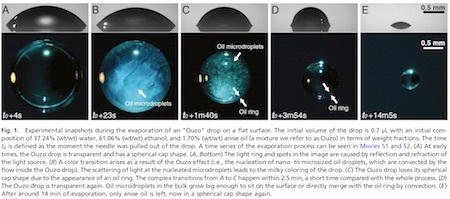
The University of Twente produced a celebratory press release. A couple of videos illustrate these goings on:
BONUS: An old video of how ouzo is said to be made:
BONUS: A look back at an effect of too much whisky and candlelight. (This, too, was Dutch research.)

July 13, 2016
Is Pilates a racial enclave or implicator of whiteness?
Jerry Coyne, writing on the blog Evolution is True, is hopped up about a study about hips. Coyne says:
The author proceeds to demonstrate that Pilates is “the embodiment of whiteness,” using just the two Pilates exercises named in the abstract. These exercises, she claims, “purposely train the body to stabilize the pelvis”, which she considers racist.
The study is: “The Pilates Pelvis: Racial Implications of the Immobile Hips,” Sarah W. Holmes, Dance Research Journal, vol. 46, no. 2, August 2014, pp 57-72. The author, at the University of New Mexico, explains:
This article examines the treatment of the pelvis in the Pilates exercises ‘Single Leg Stretch’ and ‘Leg Circles.’ The teaching practices of the hips, as commonly explained in Pilates educational manuals, reinforce behaviors of a noble-class and racially “white” aesthetic. Central to this article is the troubling notion of white racial superiority and, specifically, the colonizing, prejudicial, and denigrating mentality found in the superiority of whiteness and its embodied behaviors. Using the two Pilates exercises, I illuminate how perceived kinesthetic understandings of race in the body may be normalized and privileged. By examining the intersections between dance and Pilates history, this article reveals the ways embodied discourses in Pilates are ‘white’ in nature, and situates Pilates as a product of historically constructed social behaviors of dominant Anglo-European culture.
(Thanks to Jane Evans for bringing this to our attention.)
Here’s a Pilates video from the White Cloud Pilates Studio:

Hot Rod Magazines — A harmless diversion for teens? [podcast 72]
The danger posed by reading hot rod magazines — in the opinion of at least one English teacher — screeches, metaphorically, throughout this week’s Improbable Research podcast.
SUBSCRIBE on Play.it, iTunes, or Spotify to get a new episode every week, free.
This week, Marc Abrahams — with dramatic readings by Harvard physics professor Melissa Franklin — tells about:
The danger from Hot Rod Magazines— “Hot Rod Magazines: A Harmless Diversion?” Eleanor M. Robinson, The English Journal, vol. 54, no. 1 (1965): 36-38.
Some hot rod magazines
Some more hot rod magazines
Ed “Big Daddy” Roth’s rat fink hot rods and other hot rods
Hot Rod Magazine . The magazine, still roaring along after all these years, now also produces videos about hot rods and Hot Rod Magazine, including this video about Hot Rod Magazine‘s 65th anniversary:
The mysterious John Schedler or the shadowy Bruce Petschek perhaps did the sound engineering this week.
The Improbable Research podcast is all about research that makes people LAUGH, then THINK — real research, about anything and everything, from everywhere —research that may be good or bad, important or trivial, valuable or worthless. CBS distributes it, on the CBS Play.it web site, and on iTunes and Spotify).

July 12, 2016
Spence: Come to your (combined) senses!
Ig Nobel Prize winner Charles Spence stars in this new short video about sensibility about senses:
The 2008 Ig Nobel Prize for nutrition was awarded to Massimiliano Zampini of the University of Trento, Italy and Charles Spence of Oxford University, UK, for electronically modifying the sound of a potato chip to make the person chewing the chip believe it to be crisper and fresher than it really is. [They describe that research in the study “The Role of Auditory Cues in Modulating the Perceived Crispness and Staleness ofPotato Chips,” Massimiliano Zampini and Charles Spence, Journal of Sensory Studies, vol. 19, October 2004, pp. 347-63.]

July 11, 2016
Apple’s new anti-photog patent, and prior paparazzi-blocking tech
Apple’s new patent for (among other things) blocking photography by audience members is not a new idea. The idea harks back to — but does not mention — an earlier anti-paparazzi patent by Wilbert Leon Smith, Jr. and Keelo Lamance Jackson.
Benjamin Boles, writing for the web site Thump, explains about Apple’s idea, in a report headlined “A Tech Expert Explains What Apple’s Camera Blocking Patent Means for Concertgoers“:
While the technology has a wide variety of potential uses, perhaps most notably for blocking cameras and video recordings at concerts and other events, fears were also sparked that it could be used to suppress documenting incidents involving police violence.
In 2013 we described the earlier patent, which is based on an even earlier patent, in a report in The Guardian called “Flashy ways to fight off paparazzi, spies … and anyone else“. It begins:
A new invention aims to foil paparazzi who try to photograph people who do not wish to be photographed. Wilbert Leon Smith, Jr. and Keelo Lamance Jackson of California obtained a patent last year for what they call “Inhibiting Unwanted Photography and Video Recording”. Their invention builds on a simple idea patented in 2005 by Jeremy and Joseph Caulfield from Arizona.
The Caulfields equipped celebs with a flashgun that fires automatically the instant another flashgun fires nearby. Smith and Jackson’s device goes that bit better: it’s a rotating, swivelling, oscillating device that can emit multiple strobe lights and other light beams for as long as the celebrity deems necessary.
The device has uses beyond deterring pesky paparazzi. As Smith and Jackson explain, it can also protect our own spy agencies against nosy foreign bad guys…
Here is a technical drawing from the Smith/Jackson anti-paparazzi patent:
BONUS: Martin Gardiner’s earlier report on the Smith/Jackson anti-paparazzi patent.

Gold-digging ants – an(other) explanation
“In northern India there is a sandy desert and in this desert there live large ants, smaller than dogs but larger than foxes. A few ants that have been caught there may be seen at the king of Persia’s place. When digging their holes these ants throw out soil just like the ants in Greece to which they are similar in appearance. The sand thus thrown out contains gold and to gather this sand the Indians go into the desert.”
So wrote Herodotus somewhere around the middle of the 5th century BC. But, although there are more than 150 references to the creatures in medieval texts, not everyone is convinced – and there are no scientific records of ants that big. Perhaps their size was exaggerated? Maybe they were mistaken for some other animal? Another explanation is provide by medieval researcher Thomas Reimer [whom Improbable cannot as yet locate] who suggests that :
“The scare aspect of the story is ascribed to the fact that obtaining the gold from such deposits would have been very easy and the gold miners had to ward off competition by other diggers. Any gold rush would have endangered their profits and lowered the value of the gold on the market. Quite obviously there is no basic difference between ancient and modern economics!”
$ee (£15 plus taxes) Larger than foxes – but smaller than dogs: The gold-digging ants of Herodotus in Reinardus. Yearbook of the International Reynard Society, Volume 19, Issue 1, 2006, pages: 167 –178.
Note: The illustration is from the 14th century bestseller ‘The Travels of Sir John Mandeville’
Further reading: Ants at the Medieval Bestiary
Also see: (peculiar old animal related) Tracking down the Getulian dog

July 10, 2016
The operatic good timing of the leap-second decision
The decision to create a leap second at the end of 2016 is timely, in oh so many ways. It especially delights us, because this year’s Ig Nobel Prize ceremony will include the premier of a new mini-opera, called “The Last Second” — about a plot to secretly add an extra leap second to the world’s clocks.
A lot can happen during a leap second (some of the possibilities are sketched in a recent article in New Scientist magazine). A lot more can happen during a leap second that only one or two scientists know about in advance — that’s the crux of the opera plot. In the opera, of course, something will go very, very wrong, accompanied by music and mayhem.
BONUS: Leap second data, from NIST.
BONUS (related in spirit): Randall Munroe explores some of the implications of leap secondry, in his book What If. This drawing is part of that:

Marc Abrahams's Blog
- Marc Abrahams's profile
- 14 followers


